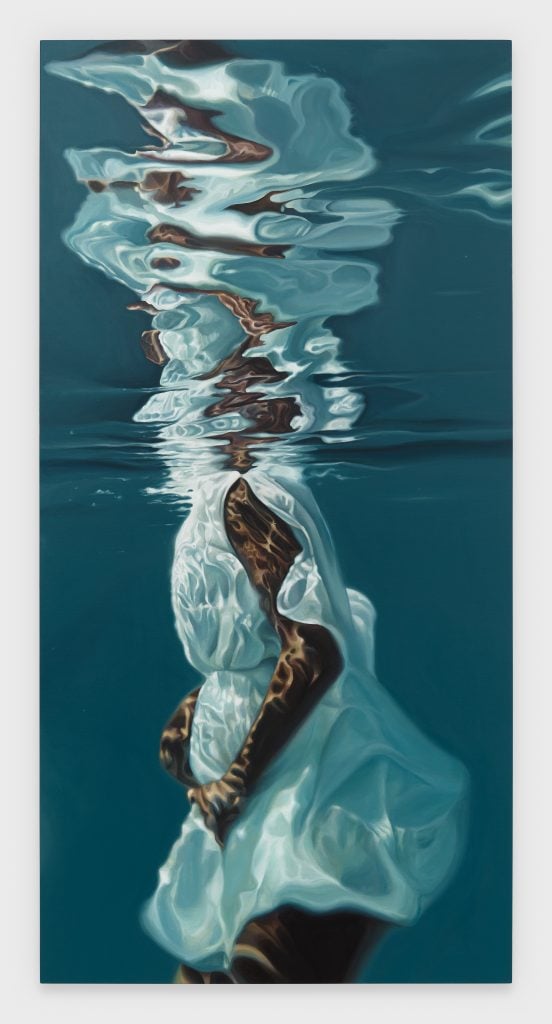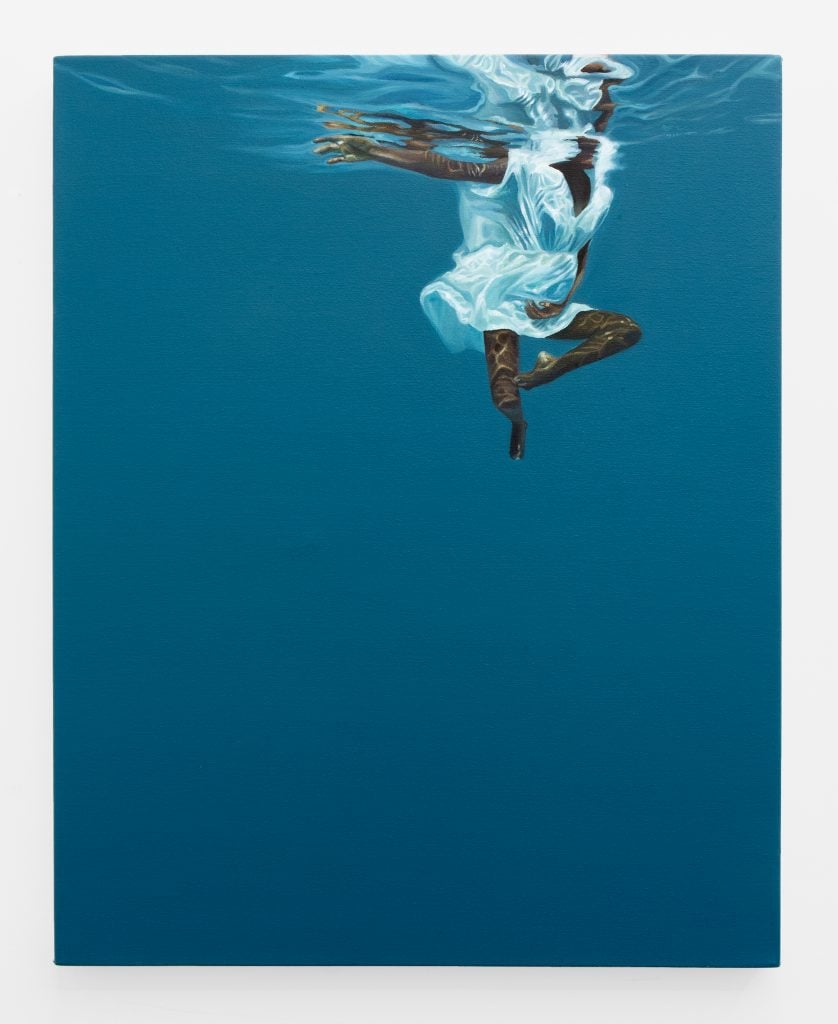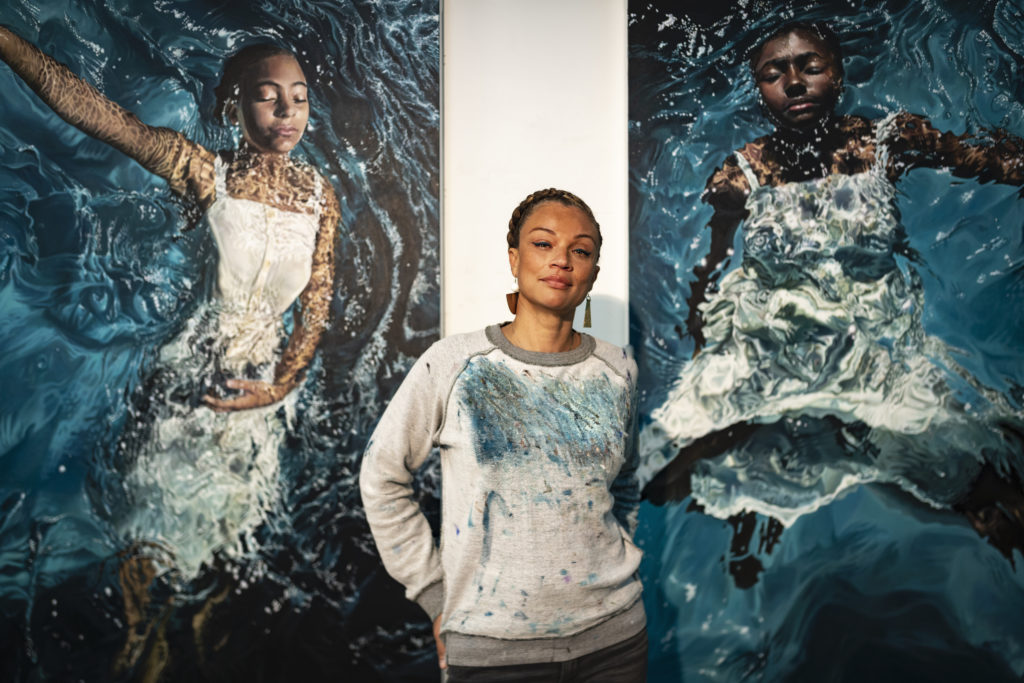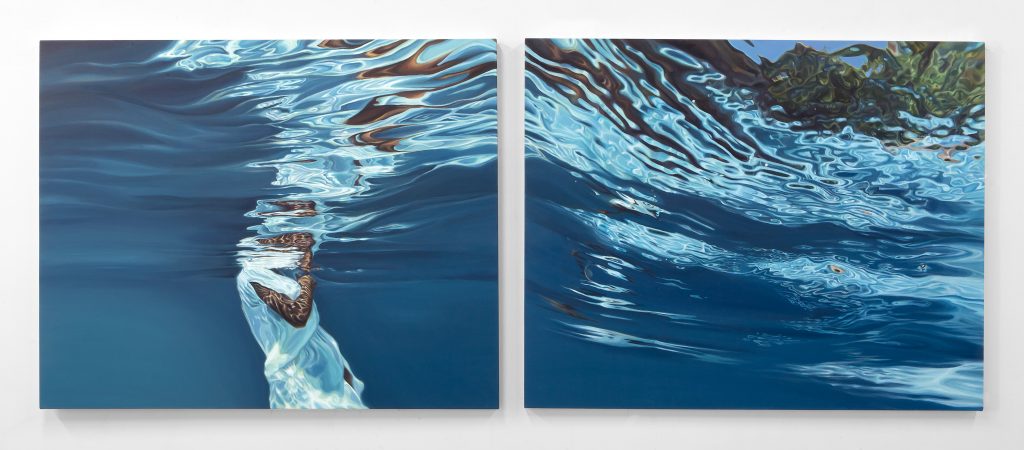People
‘We’re Coming Out From Under’: Rising-Star Artist Calida Rawles on How Her Transfixing Water Paintings Address a Year of Mourning
The Los Angeles-based artist sat down with Artnet News for a wide-ranging conversation.

The Los Angeles-based artist sat down with Artnet News for a wide-ranging conversation.

Noor Brara

When I called Calida Rawles to do this interview, it was with a rare and welcome amount of familiarity. We had spoken already a few times times this year. The first time was about her show, “A Dream For My Lilith,” at Various Small Fires in Los Angeles, where in February she debuted the latest in what she calls her “water work”: paintings in which Black boys and girls float blissfully in pools amid gently undulating waves.
We spoke once more in the middle of the summer, just as the protests in the names of George Floyd, Breonna Taylor, and so many others were beginning to take shape in cities across the US. That time, we discussed what it meant to be a Black artist working in white spaces. And now, as 2020, with all of its ricocheting chaos, winds to a close, we were speaking again.
It’s been a difficult year. But here is the thing: “This has been the time to talk about my work,” Rawles says. “It’s been one of [my] best years as an artist. I’ve been introduced to a world in which people are asking to interview me. It has been, in that respect, my time.”
“I wasn’t able to talk about my work before,” she adds. “And this year, I’ve not only been able to share more about how I feel and who I am, but [I’ve also been able to] give context to the work, which is the only way I have right now to get the painful energy out. I’m hoping I can talk about these divisive issues in a beautiful way so people can come close to them.”
Rawles has spent a lot of the last year grieving and thinking about grief. People who saw her LA show cried before her paintings, while others wrote letters to the artist, marveling at her uncanny ability to juxtapose Black joy and pain. She attended protests with 40 families from her kids’ preschool over the summer. And just last month, Kurt Reinhold, a family friend who suffered from mental illness, was killed in San Clemente by police after jaywalking. “I know his wife and his children, who go to the same daycare as my kid,” Rawles says. “I was wrapped up in that. It was like, ‘Oh, okay, another soul lost. Another family in mourning. And for what?’”

Calida Rawles, Guardian (2020). Image courtesy the artist and Various Small Fires, Los Angeles/Seoul.
Calida Garcia Rawles was born in 1976 in Wilmington, Delaware, where she grew up in a working-class family: her parents were post-office and Amtrak employees. Her heritage, she told New York magazine in March, is mixed: “My grandmother would never count her great-grandparents as family because they were slave masters, though she knows their names.”
As a child, she grew up engaged with art and literature, equally captivated by the works of Adrian Piper, Ana Mendieta, and Jenny Saville as she was by the writings of Claude Brown, E.L. Doctorow, and James Baldwin. “I juggled those two loves for a long time,” Rawles says. Selecting art as her major at Spelman College over English and psychology was a “slow process of elimination.”
“Painting was the thing I felt I could do all day and all night, and I would lose myself in time,” she says. “I can sit for 12 hours and just be there. My problem is remembering to eat or to get up and stretch my back. When I’m going, I don’t want to stop. And that was different from writing or reading, two other art forms I love hard, just differently.”
Yet literature is, in many ways, her art’s driving force. On most days, there is an audiobook playing behind her while she paints. When the tape runs out, it’s often the only thing that can pull her out of her hyper-focused trance and quietly suggest it’s time to go home. Nothing excites Rawles more than boxes of hardcover books: she almost named her daughter after Hazel in Watership Down. And it was Ralph Ellison, arguably the writer she comes back to most frequently, whose lyrical depictions of light inspired her to examine how it manifests in and around water.
“The preface of Invisible Man… I remember telling myself when I first read it, ‘When I become an adult and I have my own house, I’m going to frame pages of this book and hang them,’” Rawles says. “I remember reading and rereading those passages because I loved the concept of light, and how he needed so much of it to be seen as a Black man.”

Calida Rawles, Deep Surrender (2020). Image courtesy the artist and Various Small Fires, Los Angeles/Seoul.
Around seven years ago, Rawles learned to swim. Because of segregationist laws, which barred Black Americans from beaches and pools across the country, her parents and grandparents never learned themselves. When she was a girl, her father told her stories of his childhood on the Eastern Shore of Maryland; though he lived just an hour away from the beach, he was only allowed to go once a week—and even then, only to walk along the boardwalk. He came to equate beaches with limitation and racism.
Later in life, after Rawles discovered a deep sense of tranquility in swimming laps, she began to explore what that could look like on canvas. She started photographing Black girls, boys, men, and women in water, and translated those images into hyperreal paintings that capture the joy and release she felt while swimming.
“When I ask people to model for me, sometimes they’ll say, ‘You want to pay me? Sure, I’ll come!’ And then they get there, and sometimes they can’t swim at all,” Rawles says. “They’re afraid to let their feet up. And I would forget, in the beginning, to ask if they could swim. But whether they could or couldn’t has never stopped me. The process of working with them to relax became part of the work. Some of my most beautiful pieces are of people who are only in the water from the waist down.”
Rawles began to read more about water, too, researching, in particular, the idea of water-memory theory, which proposes that water can remember and preserve what runs through it. She wondered how this might apply to the Middle Passage, the triangular sea route through which enslaved Africans, locked into packed ships, were forced westward.

Rawles flanked by her two works Reflecting My Grace (2019) at left and Radiating My Sovereignty (2019) at right. Photo by Glen Wilson.
“It all centers on my personal exploration,” she says. “I’m going to take you on a ride as I try to work through this layered experience while painting this galaxy-like water world that’s dazzling and dream-filled. I want to talk about these difficult, divisive issues, but I also want the work to be seductive. I’m going to paint you something beautiful and I’m going to hide some stuff up in there. I never thought making this work would be about teaching my history. But it is, and I think that’s a beautiful and necessary thing.”
The paintings earned Rawles attention. Even before their formal debut at Various Small Fires, she had already sold them all, in part because one work graced the cover of Ta-Nehisi Coates’s debut 2019 novel, The Water Dancer. In that image, a man submerged in water, his arms raised over his head, looks to be dancing. But the pose just as quickly recalls the aftermath of an act of police violence. (Coates, a close friend of Rawles’s, owns four of her paintings, and sought her opinion on several drafts of The Water Dancer before its publication.)
Acknowledging and releasing pain is what Rawles does so well, especially in Reflecting My Grace and Radiating My Sovereignty, her two best-known works. Each captures her daughter and her best friend floating in water, wholly lost in the moment with visible concentration. Paintings of Black girls and women, in particular, are arguably where the artist’s talent shines brightest.
“Black women in this country view themselves through three different lenses: as a female person, as a Black person, and as an American,” Rawles says. “Sometimes people—many of them women—write me just to say they want to learn to swim. And I think maybe they’ll learn to love water, too, and they’ll talk about it one day as I do.”

Calida Rawles, New Day Coming (2020). Courtesy of the artist and Various Small Fires.
Rawles’s paintings have become especially resonant in a year marked by protests against police killings of innocent Black people, and a global health crisis that has disproportionately affected Black and brown communities. Yet shortly after our call, Joe Biden was officially and finally elected President.
I emailed her to get her thoughts. In her response, optimism shined through. “Today feels like the beginning of great promise,” Rawles wrote. Biden, who represents her home state, was going to Washington alongside Kamala Harris, the first Black woman “to walk into the halls of the White House as a leader and policy maker,” Rawles noted. Harris, she wrote, “is an inspiration for Black and brown people, especially young girls of color.”
“And as if I needed anything else to be joyful about,” Rawles added, “my Spelman [College] sister, Stacey Abrams, brought a new breath into Georgia. It’s truly a new day. We’re coming out from under.”